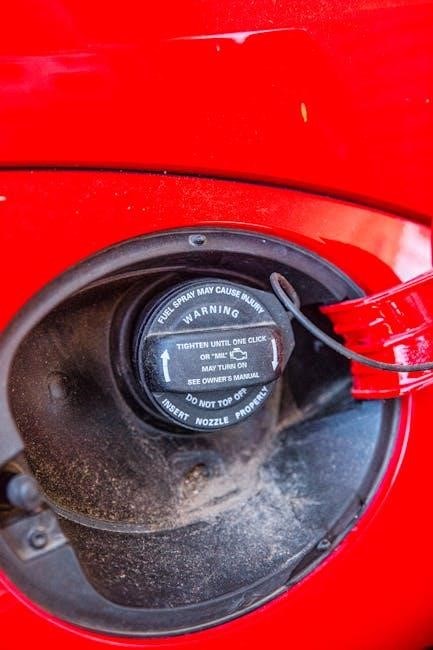This guide provides essential operating instructions, safety tips, and maintenance advice for your Ryobi Trimmer. Follow these steps to ensure optimal performance and longevity. Dependable and easy-to-use, Ryobi Trimmers are designed for efficient gardening.
Overview of Ryobi Trimmers
Ryobi Trimmers are engineered for dependability, ease of operation, and operator safety, making them a top choice for both DIY enthusiasts and professional landscapers. Known for their rugged design, these trimmers are built to handle various gardening tasks efficiently. Available in different models, including electric and gas-powered options, Ryobi Trimmers offer versatility and reliability. They feature adjustable handles, multiple cutting modes, and durable construction, ensuring adaptability for trimming grass, cutting thick vegetation, and maintaining large outdoor spaces. With eco-friendly usage options and robust performance, Ryobi Trimmers are designed to deliver years of trouble-free service when properly maintained. Their user-friendly design and advanced features make them ideal for achieving professional-grade results in home and garden care.
Importance of Following Manufacturer Guidelines
Importance of Following Manufacturer Guidelines
Adhering to the manufacturer’s guidelines is crucial for the safe and effective operation of your Ryobi Trimmer. The manual provides detailed instructions to ensure optimal performance, prevent accidents, and maintain the tool’s longevity. Ignoring these guidelines can lead to serious injury, damage to the trimmer, or voiding the warranty. Proper assembly, operation, and maintenance procedures are outlined to help you achieve professional-grade results. By following the recommendations, you can minimize risks and maximize efficiency. The manual also includes troubleshooting tips and safety precautions to address common issues. Always refer to the manual before using your Ryobi Trimmer to ensure a safe and productive experience. This comprehensive guide is essential for both DIY enthusiasts and professionals seeking reliable results.

Safety Precautions
Always wear protective gear, including gloves and eyewear, when operating your Ryobi Trimmer. Ensure the area is clear of debris and bystanders. Follow all warning labels and instructions to minimize risks and ensure safe operation.
General Safety Rules
To ensure safe operation of your Ryobi Trimmer, always follow these guidelines: Wear protective gear, including gloves, safety glasses, and long pants. Keep loose clothing and long hair tied back. Clear the work area of debris, children, and pets before starting. Avoid operating the trimmer in wet conditions or near open flames. Never touch electrical components with wet hands. Maintain a firm grip on the handle and avoid overreaching. Keep the trimmer blade or string away from your body and bystanders. Follow all instructions in the manual and use the tool only for its intended purpose. Regularly inspect the trimmer for damage and ensure all parts are securely attached. Proper maintenance and adherence to these rules will help prevent accidents and ensure safe, effective use of your Ryobi Trimmer.
Warning Labels and Symbols
Warning labels and symbols on your Ryobi Trimmer are crucial for safe operation. These labels highlight potential hazards and provide essential safety information. Common symbols include warnings for rotating parts, electrical components, and hot surfaces. Always read and understand the meaning of these labels before use. They are designed to alert you to dangers such as cutting hazards, electrical shock risks, and overheating. Pay special attention to symbols indicating protective gear requirements, such as safety glasses or gloves. Failure to heed these warnings can result in serious injury or damage. Refer to the manual for a detailed explanation of all symbols and their meanings. Ignoring these warnings can lead to accidents, so always prioritize caution and adhere to the guidelines provided.
Protective Gear Recommendations

Wearing appropriate protective gear is essential when operating a Ryobi Trimmer to minimize the risk of injury. Always wear safety glasses or goggles to protect your eyes from debris. Durable gloves improve grip and reduce vibration impact, while long sleeves and pants can prevent skin irritation from flying particles. Sturdy, closed-toe footwear is also recommended to protect your feet from accidental cuts or drops. A face mask can be useful to avoid inhaling dust or grass clippings. Ensure all clothing is snug-fitting to avoid entanglement with moving parts. By following these recommendations, you can enhance safety and ensure a secure operating experience. Protective gear is a critical component of responsible trimmer use and accident prevention.

Assembly and Initial Setup
Start by carefully unpacking and inventorying all components. Attach the trimmer head and adjust the handle to your preferred height. Follow the manual for precise assembly steps to ensure proper function and safety during use. Proper setup is crucial for optimal performance and ease of operation.
Unpacking and Inventory
Begin by carefully unpacking your Ryobi Trimmer and verifying all components against the provided parts list in the manual. Ensure no items are damaged or missing. Inspect the trimmer head, handle, battery (if applicable), and additional accessories like cutting lines or blades. Familiarize yourself with each part to understand its function. Check for any visible damage or defects and contact customer support if necessary. Properly organizing and accounting for all parts ensures a smooth assembly process. This step is crucial for identifying any potential issues before use. Take your time to ensure everything is in order and ready for assembly. A thorough inventory helps prevent delays and ensures safety during operation.
Attaching the Trimmer Head
To attach the trimmer head, align it with the shaft, ensuring the mounting holes match up. Secure the head using the provided screws or clips, tightening firmly but avoiding overtightening. Double-check the alignment to ensure proper function. Once attached, test the head by gently moving it to confirm it is securely fastened. If your model uses a quick-release mechanism, follow the specific instructions for locking the head in place. Always refer to the manual for model-specific guidance, as attachment methods may vary. Properly attaching the head ensures safe and effective operation. Take care to ensure all connections are secure before use to avoid accidents or poor performance.
Adjusting the Handle
Adjusting the handle on your Ryobi Trimmer is essential for comfortable and efficient operation. Most models feature a telescoping handle that can be extended or retracted to suit your height. To adjust, locate the locking mechanism, typically a knob or button, and release it to slide the handle to your desired length. For fixed handles, check if the angle or position can be modified for better ergonomics. Ensure the handle is securely locked in place after adjustment to prevent shifting during use. Proper handle alignment reduces fatigue and improves control. Always refer to your specific model’s manual for detailed instructions, as adjustment methods may vary slightly between models. Adjusting the handle correctly ensures a comfortable and safe trimming experience.

Operating the Trimmer
Operating your Ryobi Trimmer safely and effectively requires reading the manual, following safety guidelines, and using proper techniques. Ensure the trimmer is fully assembled and adjusted before use.
Starting the Trimmer
To start your Ryobi Trimmer, ensure all safety precautions are followed. For electric models, plug in the battery and ensure it is fully charged. For gas models, check the choke and primer. Pull the starter cord gently until resistance is felt, then pull sharply. Always wear protective gear and ensure the area is clear. Refer to the manual for specific starting procedures. If the trimmer does not start, check the fuel level, air filter, and spark plug. Ensure the trimmer head is clear of debris. Starting the trimmer correctly ensures efficient operation and prevents potential damage. Always follow the manufacturer’s guidelines for a safe and successful start.
Basic Operating Techniques
Mastering basic operating techniques ensures effective and safe use of your Ryobi Trimmer. Hold the handle firmly, keeping the trimmer head parallel to the ground. Move in controlled, steady sweeps, applying light pressure. For optimal results, maintain the cutting line 2-3 inches above the ground to avoid damaging plants. When trimming around obstacles, use short, precise strokes. Always keep the trimmer head at a slight angle to prevent debris from flying back. Regularly check the line feed and adjust as needed. Proper technique minimizes wear on the trimmer and enhances cutting efficiency. Follow these guidelines to achieve professional-looking results while maintaining safety and tool longevity.
Using the Trimmer in Different Modes
Ryobi Trimmers often feature multiple operating modes, such as trimming, edging, and brush cutting. For trimming mode, use the standard cutting line for grass and weeds. When switching to edging, adjust the trimmer head to a vertical position for precise edge work. If your model includes a brush cutter mode, install the appropriate blade for tackling thicker vegetation. Always refer to the manual for specific mode-changing instructions. Ensure the trimmer is turned off and cool before switching modes. Properly securing attachments and using the correct accessories for each mode ensures safety and efficiency. Adapting your technique to the selected mode enhances performance and extends the tool’s lifespan.

Maintenance and Care
Regular cleaning and proper storage are essential for maintaining your Ryobi Trimmer. Seasonal checks ensure optimal performance, while replacing worn parts keeps it reliable and prolongs its lifespan.
Cleaning the Trimmer
Cleaning your Ryobi Trimmer is crucial for maintaining performance and longevity. Start by disconnecting the battery or spark plug to ensure safety. Remove any debris, grass clippings, or dirt from the trimmer head and line. Use a soft brush or cloth to wipe down the exterior, paying attention to vents and openings. For stubborn dirt, mix mild detergent with water and gently scrub. Rinse thoroughly and dry to prevent rust. Regularly inspect and clean the air filter to ensure proper airflow. Check for worn or damaged parts and replace them as needed. Cleaning after each use prevents damage and keeps your trimmer in optimal condition.

Storing the Trimmer
Proper storage of your Ryobi Trimmer ensures longevity and readiness for future use. Disconnect the battery or drain fuel if it’s a gas model. Clean the trimmer thoroughly, removing dirt and debris. Store it in a dry, cool, well-ventilated area away from direct sunlight. Avoid damp or humid environments to prevent rust. For electric trimmers, wind the cord neatly to avoid tangling. Check for wear and tear, and repair or replace damaged parts before storage. Use a protective cover to shield from dust. Store the trimmer upright or in its original packaging if available. Proper storage maintains performance and prevents damage during the off-season. Always follow manufacturer guidelines for specific storage recommendations.
Seasonal Maintenance Tips
Regular seasonal maintenance ensures your Ryobi Trimmer remains in peak condition year-round. After each use, clean the trimmer head and remove debris to prevent clogging. Check and replace the cutting line or blade as needed. Inspect the air filter and spark plug, replacing them if dirty or worn. For gas models, drain the fuel tank or use a fuel stabilizer before storage. Lubricate moving parts to prevent rust and corrosion. Store the trimmer in a dry, cool place during the off-season. Before restarting in spring, perform a thorough inspection and test the trimmer. Proper seasonal care extends the lifespan and ensures reliable performance when needed.

Troubleshooting Common Issues
Address issues like uneven cutting, vibration, or battery drain. Check for worn parts, clogged air filters, or loose connections. Refer to the user manual or online troubleshooting guides for solutions.
Trimmer Not Starting
If your Ryobi Trimmer fails to start, check the power source or battery charge. Ensure the battery is fully charged and properly connected. Verify the spark plug is clean and securely installed. Check for clogged air filters or fuel lines, and ensure the fuel tank is not empty. If using a gas-powered model, confirm the choke is in the correct position. Consult the user manual for specific troubleshooting steps, as different models may have unique requirements. If issues persist, contact Ryobi customer support or visit an authorized service center for professional assistance.
Line Feed Problems
Line feed issues are common and can usually be resolved with simple adjustments. Ensure the cutting line is correctly installed according to the manual. If the line isn’t advancing, check for tangles or debris in the spool. Clean the spool and rewind the line properly. For automatic feed models, tap the head gently on the ground to activate the feeding mechanism. If manual feeding is required, stop the engine and pull out additional line. Avoid overloading the spool, as this can cause malfunctions. Regularly inspect and replace worn or damaged lines to maintain optimal performance.
Overheating Issues
Overheating can occur due to blocked air vents, excessive use, or improper maintenance. Ensure airflow by keeping vents clean and free from debris. Avoid continuous operation without breaks, as this strains the motor. If overheating occurs, turn off the trimmer and allow it to cool. Regularly inspect and clean the cooling system to prevent future issues. Use the correct cutting line size and type, as thicker lines can cause increased friction and heat buildup. Always follow the manufacturer’s guidelines for operation and maintenance to avoid overheating problems and extend the lifespan of your Ryobi Trimmer.

Repair and Replacement
Identify wear and tear early to prevent major repairs. Replace damaged or worn parts with genuine Ryobi components to ensure safety and optimal performance.
Identifying Wear and Tear
Regularly inspect your Ryobi Trimmer for signs of wear and tear to prevent performance issues. Check the power cord for fraying, the cutting blade for dullness, and the trimmer line for depletion. Inspect the engine for leaks or damage, and ensure all moving parts are lubricated. Look for worn-out handles or loose connections, as these can affect control and safety. Consult the user manual for part numbers and diagrams to identify components needing replacement. Addressing wear early prevents costly repairs and ensures safe operation. Replace damaged parts with genuine Ryobi components to maintain optimal performance and longevity. Regular maintenance extends the life of your trimmer and keeps it running efficiently.
Replacing the Trimmer Line
To replace the trimmer line, start by turning off the engine and allowing it to cool. Wear gloves to protect your hands from sharp edges. Locate the spool at the trimmer head and remove any remaining line. Measure and cut a new piece of trimmer line to the recommended length specified in your manual. Wind the line neatly around the spool, ensuring it is properly seated. Replace the spool cover securely. Test the trimmer to ensure the line feeds correctly and cuts efficiently. Always use genuine Ryobi replacement parts to maintain performance and safety. If unsure, refer to the manual or contact Ryobi support for assistance. Regular line replacement ensures optimal cutting performance and extends the life of your trimmer.
Repairing or Replacing the Motor
Repairing or replacing the motor requires caution and adherence to manufacturer guidelines. First, disconnect the battery or spark plug to ensure safety. Inspect the motor for signs of wear, such as worn brushes or damaged wiring. For electric motors, check for overheating issues or short circuits. If repairs are needed, consult the parts manual for compatible replacements. For gas-powered motors, inspect the air filter and carburetor for blockages. If the motor is beyond repair, replace it with a genuine Ryobi part to ensure compatibility and performance. Always follow the manual’s instructions for disassembly and reassembly. If unsure, contact Ryobi’s customer support or visit an authorized service center for professional assistance. Proper maintenance ensures the motor operates efficiently and prolongs the trimmer’s lifespan.

Environmental Considerations
Eco-friendly practices are crucial for minimizing environmental impact. Proper disposal of old parts and sustainable battery care help reduce waste, promoting eco-conscious gardening habits responsibly.
Eco-Friendly Usage Tips
Adopting eco-friendly practices with your Ryobi Trimmer helps minimize environmental impact. Use rechargeable batteries to reduce waste and opt for energy-efficient modes when possible. Avoid over-trimming to preserve plant life and biodiversity. Regularly maintain your trimmer to ensure optimal performance, reducing the need for excessive fuel or energy use; Properly dispose of old parts and batteries through recycling programs to prevent environmental contamination. Consider using biodegradable cutting lines if available. Additionally, avoid trimming in sensitive ecosystems or during peak wildlife activity to protect local flora and fauna. By following these tips, you can enjoy a well-manicured lawn while promoting sustainable gardening practices.
Proper Disposal of Old Parts
Proper disposal of old Ryobi Trimmer parts is crucial for environmental protection. Always recycle batteries, motors, and metal components through designated facilities. Check local regulations for guidelines on hazardous waste disposal. Never discard parts in regular trash, as they may contain harmful materials. Use community recycling centers or manufacturer programs for safe disposal. Additionally, donate reusable parts like handles or accessories if still functional. Ensure all liquids, such as fuel or oil, are drained and disposed of according to local environmental standards. By responsibly managing waste, you contribute to a sustainable future and prevent potential ecological harm. Always follow local recycling guidelines for proper disposal processes.
By following these guidelines, you ensure proper usage, maintenance, and environmental responsibility, enhancing your Ryobi Trimmer’s performance and lifespan while promoting eco-friendly practices.
Final Tips for Optimal Performance
For your Ryobi Trimmer to perform at its best, always adhere to the manufacturer’s guidelines. Regularly clean the trimmer head and check for wear and tear. Store the tool in a dry, cool place to prevent rust and damage. Use the correct trimmer line thickness for your tasks, and avoid overloading the machine. Keep the cutting area clear of debris to ensure smooth operation. Properly charge the battery if using a cordless model, and refer to the manual for seasonal maintenance tips. By following these steps, you’ll maintain your trimmer’s efficiency and extend its lifespan, ensuring years of reliable service.
Importance of Regular Maintenance
Regular maintenance is crucial for extending the life of your Ryobi Trimmer and ensuring consistent performance. Over time, components like the trimmer line, motor, and handles can wear out. By inspecting these parts regularly and replacing them when necessary, you prevent unexpected breakdowns. Cleaning the trimmer head after each use helps remove debris that could cause corrosion or clog the cutting mechanism. Additionally, proper storage and seasonal checks ensure the trimmer remains in good working condition. Neglecting maintenance can lead to reduced efficiency and potential safety hazards. Stay proactive with routine care to keep your Ryobi Trimmer operating smoothly and safely throughout the year.
